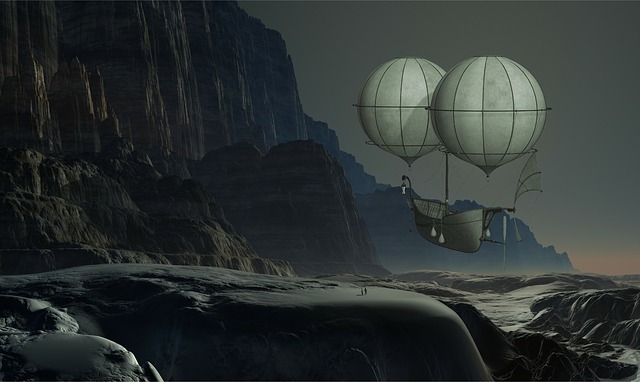In my last post on Young Adult fiction, I mentioned the relatively new genre of Steampunk and thought it would be fun to talk about.
Steampunk is a sub-genre of either science fiction or fantasy that incorporates steam-powered technology. It’s a kind of alternative history where the internal combustion engine was never invented, and so transport continued to be developed along either mechanical or steam-powered lines.
In terms of our own world history, this equates to the technology of the late 1800s — the Victorian era. Consequently, although the steam tech inventions may have capability beyond that of the Victorian era, the aesthetics and design often have Victorian influences. The juxtaposition of alternative tech and modernised Victorian societies are a compelling mix. Bronze corsets, elaborate jewellery made from gears, wooden holsters, long flowing skirts, and hats with goggles.
Many people will say that the influence of the Steampunk genre comes from when the likes of Jules Verne and HG Wells wrote about futuristic devices like airships. Clearly their tech fits into this genre because they were writing before the internal combustion engine was invented. But for us to place them retrospectively into a new genre seems odd to me. They wrote adventure stories which couldn’t include tech more advanced than their own era.
So if you were to write a Steampunk novel today, what elements should you consider the including? The following are the indicators of Steampunk, although now the genre is established certain of these elements are also rapidly turning into cliché. If you have a corset-clad airship adventuress, try and keep the trope fresh and do something new with it.
- Advanced technology of mechanical and/or steam power.
- Clockwork/mechanical devices and mechanisms
- Air borne transport based on some kind of air technology
- Victorian influences
And it’s important not to forget the second part of the word. We’ve dealt with the steam. Now for the punk. Any genre with the work punk at the end – dieselpunk, cyberpunk, biopunk etc. requires some kind of fight or rebellion against the system. You need compelling characters with a plot full of conflict. And those characters will have a punky edge. Maybe they hate the system. Maybe they’re fighting for their own case. Maybe they rebel against their boss/owner/parents. But don’t forget to put the punk in.
I think that’s where some of these arguments about what books fall into Steampunk come into play. There are plenty of books, especially older ones, that fulfil the steam but without the punk, which I suppose may be said to have its origins in the 70s with the punk rocker movement. And this attitude has manifest itself in writings after this period.
If you’re interested in Steampunk aesthetics, which is a whole movement in itself, check out my Pinterest page for some fun pictures.


I think this is a concise and adequate explanation of steam punk, and I quite like it.
Thank you 🙂
Thank you so much for expressing this definition in clear diction. I often try to describe steampunk to those that have never read it and I feel like I make my explanations way too long and unnecessary so that they get bored, but steampunk is not at all boring!
Sometimes it’s better to recommend people a specific book so they can work it out for themselves! I often recommend the Mortal Engines series to people. Thanks for stopping by 🙂
Ah! A brilliant definition for steampunk! Going to borrow this for next time I have to explain it to someone… “Here, read this blog post on it.” Or, alternatively, just send them to the Mortal Engines series (which I love.)
Yes it’s a great series 🙂
I received an education. I knew nothing of this genre. Don’t tell anyone.
Lol your secret is safe with me 😉